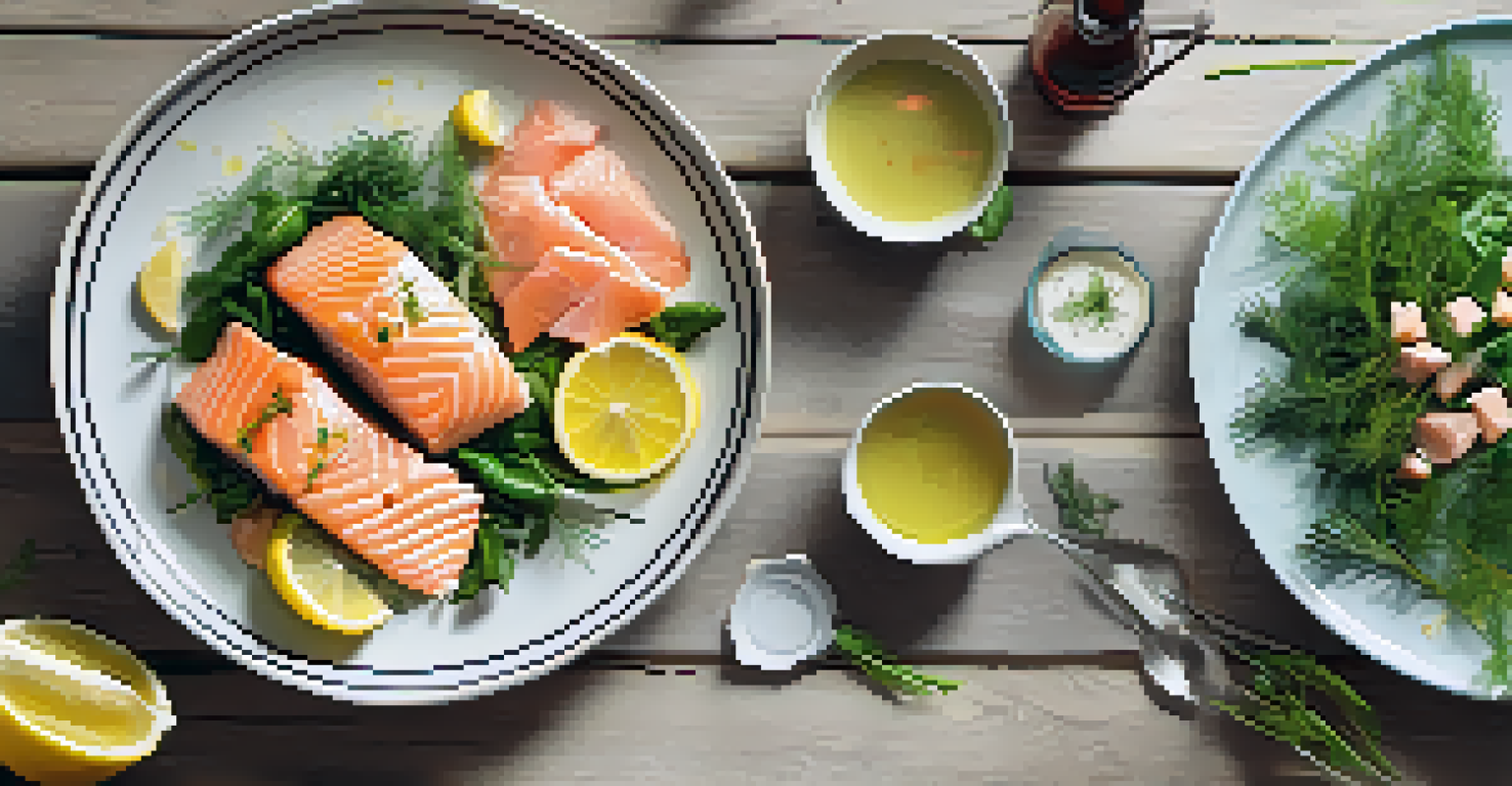The Art of Poaching: Healthy Cooking for Delicate Proteins

What is Poaching and Why Use It?
Poaching is a gentle cooking method that involves submerging food in simmering liquid. It's often used for delicate proteins like fish, eggs, and poultry. This technique preserves moisture and enhances flavor without adding extra fat, making it a healthy choice for cooking.
Cooking is like love. It should be entered into with abandon or not at all.
Unlike boiling, which can be harsh and lead to texture loss, poaching keeps proteins tender and succulent. The low temperature allows the food to cook evenly and retain its natural flavors. Think of it as a cozy bath for your ingredients, ensuring they emerge perfectly cooked.
By mastering poaching, you can elevate simple meals into gourmet experiences. Whether you're preparing a light lunch or an elegant dinner, poaching adds a touch of sophistication without requiring complicated techniques.
Essential Tools for Poaching Success
To start poaching, you don't need a fancy kitchen setup—just a few essential tools. A deep saucepan or skillet is ideal for creating the perfect poaching environment. A slotted spoon is also crucial for easily removing your cooked proteins without damaging them.

Using a thermometer can help you maintain the right temperature, typically between 160°F and 180°F. This temperature range ensures your proteins cook evenly without becoming tough. Additionally, a lid for your pan can help maintain heat and moisture, resulting in better flavor.
What is Poaching?
Poaching is a gentle cooking method that keeps proteins tender and flavorful by cooking them in simmering liquid.
Lastly, having quality ingredients on hand is vital. Fresh herbs, spices, and flavorful broths can enhance the poaching liquid, infusing your proteins with delightful tastes. Remember, the right tools and ingredients make all the difference in achieving poaching perfection.
Choosing the Right Liquid for Poaching
The poaching liquid is a key player in the overall flavor profile of your dish. Water is a common base, but think outside the box! Broths, stocks, or even wine can add depth to your proteins, transforming a simple dish into something extraordinary.
The secret of good cooking is, first, having a good dish; second, a good fire; and third, a good cook.
Herbs and spices can elevate your poaching liquid significantly. For example, adding lemon slices, bay leaves, or peppercorns can impart fresh, aromatic notes to the food. This is where you can get creative—experimenting with different combinations will lead to unique flavors.
Remember that the liquid should complement the protein you're cooking. For instance, a light fish might pair well with a delicate white wine broth, while chicken could benefit from a heartier stock. Tailoring your poaching liquid helps ensure that every bite is bursting with flavor.
The Perfect Temperature: Key to Poaching
Temperature control is crucial when it comes to poaching. The goal is to keep the liquid at a simmer, which means small bubbles should rise to the surface but not a rolling boil. This gentle heat ensures proteins cook through without becoming rubbery or dry.
Using a kitchen thermometer can help you maintain this ideal range. If you don't have one, keep an eye on the bubbles—when they start appearing but not boiling, you're in the sweet spot. This technique is not just for proteins; it works wonders for fruits and vegetables too!
Essential Poaching Tools
Having the right tools, such as a deep saucepan and a slotted spoon, is crucial for successful poaching.
Additionally, poaching time varies depending on the protein. For example, a chicken breast may take 15-20 minutes, while poaching an egg may only require a few minutes. Understanding how different proteins respond to heat will help you achieve consistent results.
Tips for Poaching Fish Deliciously
Fish is one of the most popular proteins for poaching, and it’s no wonder why. With its delicate texture, poaching can help maintain its moisture and flavor. Start by choosing a firm fish like salmon or cod, which hold up well during cooking.
Before poaching, consider marinating your fish to infuse additional flavors. A simple mix of olive oil, lemon juice, and herbs can work wonders. Once ready, place the fish gently into the simmering liquid and cook until it flakes easily with a fork.
Also, be mindful of the poaching time. Overcooking fish can lead to a dry result, so keep a close eye on it. When done right, poached fish can be a light, healthy meal that’s both satisfying and delicious.
Poaching Eggs: A Breakfast Favorite
Poached eggs are a breakfast classic, loved for their runny yolks and delicate texture. Achieving the perfect poached egg might seem daunting, but with a few simple tips, you can master it. Start with fresh eggs; they hold their shape better and create a more appealing result.
When it comes to the poaching liquid, a little vinegar can help the egg whites coagulate faster, leading to a neater final product. Simply bring a pot of water to a gentle simmer, add a splash of vinegar, and create a gentle whirlpool before sliding in the egg.
Perfecting Poaching Temperature
Maintaining the liquid temperature between 160°F and 180°F is key to cooking proteins evenly without making them tough.
Timing is everything! Generally, poaching an egg takes about 3-4 minutes for that perfect runny yolk. Once cooked, remove it with a slotted spoon and place it on a paper towel to drain excess water. Serve on toast, salads, or simply enjoy on its own!
Healthy Poaching Recipes to Try Today
Now that you're equipped with poaching knowledge, it's time to put it into practice! Try poaching chicken breasts in a flavorful broth with herbs and vegetables for a wholesome meal. This dish pairs beautifully with a light salad or quinoa for a balanced dinner.
For seafood lovers, consider poaching shrimp in a garlic-infused broth. This quick dish cooks in just a few minutes and can be served over pasta or rice for a satisfying meal. Don't forget to garnish with fresh herbs for an added touch of flavor.

Lastly, if you're in the mood for breakfast, experiment with poached eggs on avocado toast. It's a simple yet elegant dish that’s packed with nutrients and flavor. These healthy recipes showcase the versatility of poaching and will keep your meals exciting!